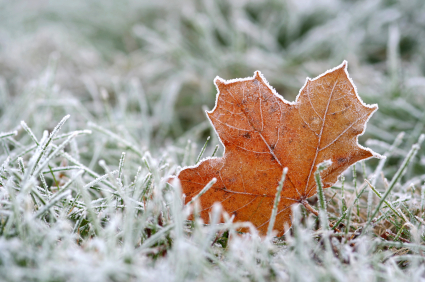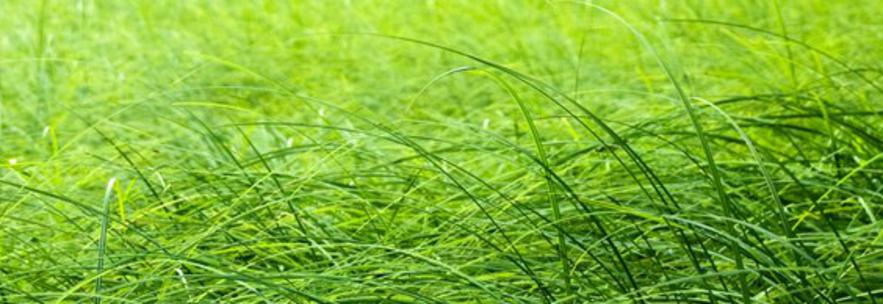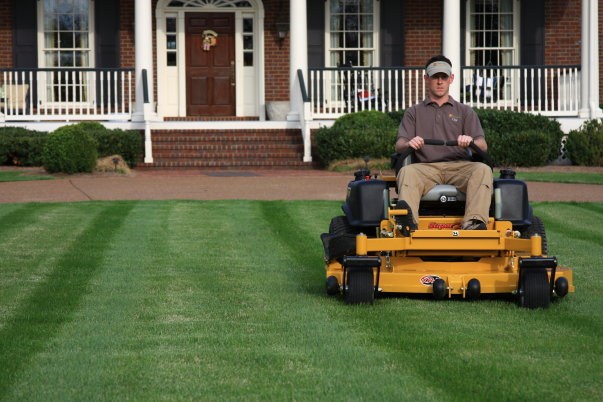Lawn Services of Omaha - Lawn and Landscaping
Winter Care For Potted Plants
by David Steg on 12/04/15
For plants to survive the winter outdoors unharmed, they must be well prepared. Generally, only winter-hardy plants can remain outside in winter. For every plant, winter means stress. Winter protection for plants means that they are sheltered from frost, excessive dryness and too much moisture.

Firstly, dead leaves and buds should be removed from the plant. This prevents the plant from investing too much energy which it urgently needs for winter. Plants should generally not be fertilised in winter.
Covering the root area is important winter protection for all plants. Straw, bark mulch or autumn leaves help to make the plants winter-hardy. They protect the sensitive parts of the plant against cold air. In addition, the pots of winter-hardy tub plants must be wrapped. Fleece, coconut mats or bubble-wrap, which all prevent the soil freezing, are all suitable for this. Balcony plants should be protected with the same measures.
Plants in pots and tubs are very thirsty during frost-free periods, especially those which are under eaves. Evergreen plants constantly lose water in winter via the leaves. Especially on sunny days and in strong wind, more water is needed than is supplied by rain. Most plants react to the lack of water with wilted leaves. In winter, dry damage is frequently confused with freezing damage. How much water plants need in winter depends on the size of the container. When watered, you should ensure that the water runs out of the pot at the bottom. In the case of plants in large pots, ten litres may well be required. Due to the risk of frost, the flower pots should be placed on clay feet or wooden chocks.
Tips for Winter Tree Protection
by David Steg on 12/02/15
Winter can be a harsh time for plants, even for the plants in your yard that seem the toughest—namely, your trees. Find out how to help your trees last through the winter and come back strong in the spring using the following tips.
- Shake Off Snow and Ice – Though snowy trees are a beautiful sight, built up snow and ice can strain tree branches to the breaking point. You can use a broom to gently shake the branches and brush the snow away, but be careful not to shake too roughly and cause the branches to crack. If the branches of your tree are sagging under the weight of the snow, it’s a good indication that a brushing is in order.
- Wrap Them Up Warm – It seems silly, but trees actually can benefit from being wrapped up during intense winter storms such as ice storms. If you have a heavy storm in your forecast, you may want to add wrapping your trees in burlap fabric to your list of safety precautions.
- Provide a Stable Temperature –You can use plastic wrap to help trees maintain a stable temperature in winter. This is important because of a winter phenomenon known as “sun scald,” which is when freezing trees are exposed to bright winter sunlight, causing the bark of the tree to come out of dormancy only to be killed when the sun is blocked or goes down again. This will harm the tree, but can be prevented by wrapping trees in plastic wrap, paying special attention to the south/southwest sides.
- Protect Trunks – The trunks of your trees can do with a little protection in the late fall and early winter, as wild animals will eat parts of your tree and use others for shelter-building. Trees whose bark is stripped away at the base can become sick and even die. If you don’t want your trees used by animals for these purposes, you can wrap the bases of your trees in wire mesh.
- Fertilize in Fall – Fertilizing your lawn in fall is a great way to ensure that all of your lawn plants are healthy enough to withstand the challenges they’ll face in winter. However, you should only fertilize in the fall if the weather will not reach below freezing temperatures during the winter, as it will keep them “awake” during winter when they should go dormant. If your winters are fairly mild, fertilization will simply give your tree some extra strength.
Watering In The Winter Months?
by David Steg on 11/30/15
Do I Need to Water my Grass in the Winter Months?
Logic tells us that as cooler weather sets in during the winter, grasses require far less water than during the summer months. The amount of water lost through evaporation and transpiration slows considerably and the growth rate of grasses slows down as well. In South Carolina warm-season grasses such as St. Augustine, Zoysia, Bermuda, and Centipede go into a dormant stage as temperatures begin to lower. Although these warm-season grasses turn brown and appear to be dead, they are very much still alive and await warmer temperatures in the spring to begin new growth.
Since these grasses are still alive yet dormant, the question becomes "Do I need to water my lawn during the winter months?" The answer is a definite "Maybe". Irrigation during the winter months in South Carolina will not need to occur often, but there are times when supplemental water will help warm-season grasses such as St. Augustine, Zoysia, Bermuda, and Centipede survive the winter. During times of low humidity and windy conditions in the winter months, grasses are prone to drying out. If warm-season grasses dry out too much, they may be vulnerable to quick drops in temperature that may lead to a condition called winter kill.
Due to constantly changing weather conditions in the Southeast, scheduling irrigation during the winter months is almost impossible. To help better predict when to irrigate, new irrigation controllers known as "smart controllers" are helping individuals make informed decisions on when to irrigate. Smart controllers utilize weather stations or soil moisture sensors to determine when and how long to run irrigation cycles. These newest irrigation controllers take the guess work out of scheduling irrigation cycles.
Soil moisture sensors are extremely accurate in reading how moist or dry your lawn is. If the soil drys out to the point where it needs to be water, the sensor relays that information back to the irrigation controller to allow it to water the lawn. Some smart controllers use small weather stations that take recordings of the conditions around them to allow irrigation cycles to run when needed.
These newest irrigation controllers can save time and money by not wasting water and having to continually change run times due to changes in the weather. Many users have saved 20-50% of their irrigation water bill by using smart irrigation controllers that utilize soil moisture sensors or weather stations. These types of irrigation controllers keep landscapes healthier by only applying water when it is needed and by applying the proper amount. The good news is that they can pay for themselves in as little as one season due to their water saving features.
There may be times when your lawn needs irrigation during the winter months. It won't be very often, but if it does need water, smart irrigation controllers can make informed decisions on when to irrigate and how much water to apply. To learn more about the different smart irrigation controllers offered by W.P. Law Inc., check out the links below for specific product information. Save time, money, and water with smart irrigation controllers.
Winterize Your Lawn
by David Steg on 11/30/15

If all the conflicting advice about whether or not to winterize your lawn has left you confused, you’re not alone! But figuring out what to do may not be as hard as it seems. Here’s what you need to know about how to prepare your lawn for winter.
What Is a Winterizer?
Your lawn’s nutrient needs change in the fall in preparation for the cold weather ahead. Winterizing fertilizers are high in potassium (chemical symbol: K), the third number listed on the fertilizer label.

Winterizers have a higher potassium content than other lawn fertilizers.
Potassium is a very important nutrient in overall plant health. It works at the cellular level to strengthen and harden plants from top to bottom, making them more tolerant of cold and stress. Potassium also helps a plant absorb other nutrients, making it an important component of balanced feeding for your lawn.
The other two nutrients in fertilizer are nitrogen, the first number (chemical symbol: N), which promotes leaf and stem growth; and phosphorus, the middle number (chemical symbol: P), to enhance root growth and fruit production.
Commercial winterizer fertilizers usually contain higher levels of potassium and lower levels of nitrogen than early-season “turf building” type fertilizers. For example, Scotts Winter Guard fertilizer has an N-P-K number of 24-2-14 while their standard Turf Builder is 29-2-4.
Winterizers Are for Cool-Season Grasses

Most commercial winterizers are formulated for cool-season grasses such as fescue and bluegrass. These type of lawns:
- Have their peak growing season in the fall, so that’s a great time to feed them.
- Need increased potassium and decreased nitrogen as the season progresses.
Some lawn care professionals believe that a fall application of winterizer is the single most beneficial thing you can do for cool-season lawns, and the best choice if you’re only fertilizing once. Among the main commercial fertilizers, winterizers are more balanced than turf-builders, so they’re a better choice for once-a-year feeding.
Warm-Season Grasses Beware
Winterizers should not be used with warm-season grasses (Bermuda, St. Augustine, zoysia, centipede) because they:
- Go dormant in the winter while an application of fertilizer spurs new growth.
- Grow in warmer climates where winterizing is less of an issue.
- While warm-season grasses need potassium, it should be applied during spring and summer instead of fall.

The nutrient ratio is more important than the name on the label.
What’s All The Hype?
If you follow the seasonal parade of fertilizer products, winterizers are last in the lineup of recommended summer and fall fertilizers. But look closely and you’ll notice that the earlier feedings are almost pure nitrogen, because nitrogen is what makes your grass green and thick.
Winterizers appear on shelves in the fall to provide the potassium that was left out of the earlier products. It’s quite a clever marketing plan, but it can cost you a fortune! If you substitute a slow-release fertilizer with more balanced nutrients for the typical summer blend, you can cut down on the number of applications needed.
For established lawns, turf experts recommend feeding with at least three parts nitrogen for every one part potassium to provide maximum green-up and overall health, with at least half of the nitrogen in a slow-release form. Many commercial fertilizers now contain little or no phosphorus due to pollution concerns.
Lawn fertilizer should be applied during the peak growing season (spring for warm-season grass, fall for cool-season). While you may find fertilizers with these ratios labeled as “winterizers,” they can be applied anytime that’s right for your lawn.

Fall is a great time to feed cool-season lawns.
Do I Need to Winterize My Lawn?
- Conduct a soil test. If it shows adequate levels of potassium in your soil, you don’t need winterizer.
- If you’ve been feeding your lawn with balanced nutrients all season (such as organic fertilizer or compost), you shouldn’t need to worry about winterizing, as there will still be plenty of potassium available in the soil during fall.
- Cool-season grass will benefit from fall feeding. You can use a winterizer or another fertilizer as long as it contains both nitrogen and potassium. Or supplement your lawn throughout the season with potassium from organic sources.
- For warm-season grasses, wait until late spring to fertilize and feed with balanced nutrients.
Winterizers, like other chemical fertilizers, are commercial products designed for repeated use. Chemical fertilizers do not improve your soil and need to be applied again the next season.
For a low-maintenance, low-budget, healthy lawn, consider switching to organic lawn practices such as top dressing, mulch mowing, core aeration, and slow-release organic fertilizers. Over time, these practices will condition and enrich your soil, giving a healthier lawn that requires less maintenance.
Tips for Winter Lawn Care
by David Steg on 11/26/15
The winter is when you spend the least amount of time thinking of your lawn. Unless you live in an area that is relatively warm all year long, chances are you have put the lawn mower away and are ready for a few months of relaxation before you have to start the lawn maintenance routine again.
There are a few things you can do during even the harshest winter that can ensure a beautiful, lush yard once spring rolls around again.

Fertilizing in the Winter
Late Fall or early winter are the best times to fertilize cool season grasses. Since the majority of the lawns in North America are made from these grasses, like Bermuda and bluegrass, it is a good bet your yard has a typical cool season blend.
Before the first freeze, give your lawn a thorough fertilizing to replace all of the nutrients that can be lost from the soil during the hot summer months. Once the weather turns cold, the fertilizer will remain in the soil and feed your lawn’s roots all winter long.
When spring comes your lawn will be full of healthy, lush, green grass that has been feeding on good fertilizer nutrients underneath the snow.
Mowing Strategies
During the last month of the summer you should gradually lower the cutting base of your lawn mower each time you mow the lawn. Slowly cutting your grass shorter will allow it to winter well without shocking it by cutting it all off at once.
If you leave your lawn too tall during the winter months it will be prey to field mice and other burrowing animals that want a warm place to sleep. Mice can destroy large parts of your lawn by building nests. They create dead spots where they spend all of their time as well as pulling up large amounts of grass to build their structures.
Make sure your grass is as short as possible at the end of the season. Short grass also protects any new growth that may be more fragile near the end of the growing season.
Keep it Clean
It is easy for items to be left on the lawn during the long, cold winter when no one goes outside very often. Stray logs, toys, and even lawn furniture can be accidentally overlooked before the first snow comes.
Make sure that you clear the lawn of all objects after you mow it for the last time of the year. Do an occasional sweep of the lawn every couple of weeks during the winter, as well.
If an object is left on the grass during cold weather and snowfall it can create large dead spots because of the weight of the object. In the spring the grass in that area will be stunted and thinner than the rest of the yard.
Avoid Excessive Lawn Traffic
When the grass is brown and short it can be easy for people to forget that it shouldn’t be walked on. Try to prevent very much foot traffic on your winter lawn. Grass is relatively resilient, but it will have a difficult time recovering if a path becomes well worn across the lawn.
- Keep your sidewalks cleared of ice and snow so that you and your guests won’t be tempted to cut across the yard very often.
- Never allow anyone to park a truck or a car on your lawn. Even the smallest vehicle will leave impressions in the soil and kill off the grass that is underneath the tires. Using the lawn as a parking lot is the fastest way to kill the good grass and make room for crabgrass and other types of weeds.
Prepare in the Fall
There really is not much lawn care that needs to be done during the cold months of winter. If you properly prepare the lawn during the fall, it will be fine until the warm days of spring arrive once more.
- Make sure you aerate, fertilize, and mow the lawn before the first freeze of the season.
- Rake away any dead leaves that may have fallen and collected on your yard to avoid wet spots that can become mossy or moldy.
- Keep the lawn cleared of debris and help everyone in the family respect the yard while it is dormant.
Once you have taken care of everything that needs to be done during the fall you will be ready to enjoy a nice cozy winter indoors with your family before lawn care season begins again in the spring.





